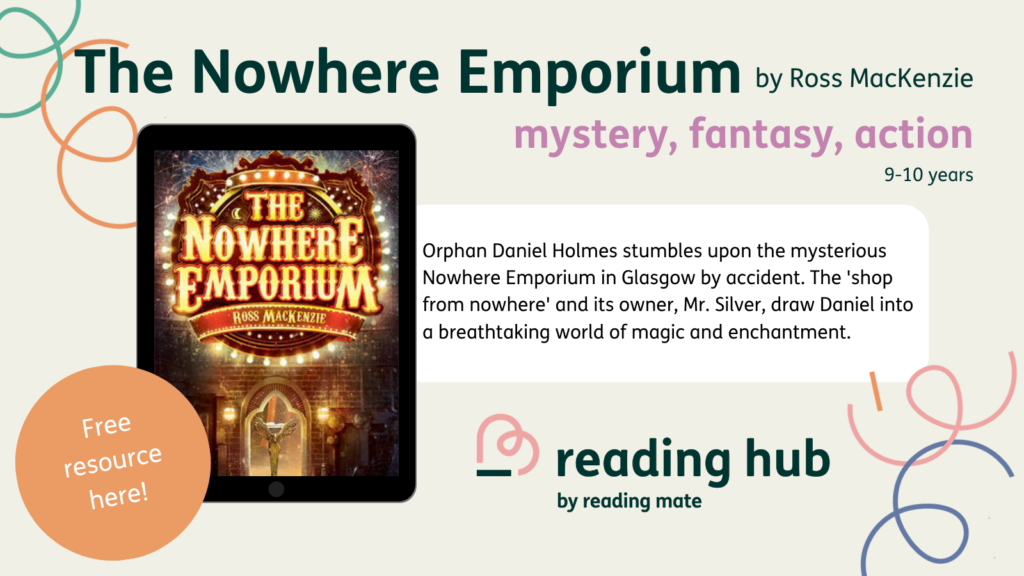Reading culture in schools matters because it helps to create well-rounded individuals who can think critically and analytically. When learners are exposed to a wide variety of reading materials, they can develop a better understanding of the world around them.
A recent study by the National Endowment for the Arts found that students who read frequently are more likely to score higher on standardised tests and perform better in later life. In addition, the reading culture in schools supports the learning of all subjects, not just English.
Looking for lesson ideas and resources to help in the classroom? Check out this series of activities for The Nowhere Emporium by Ross MacKenzie.


The benefits of a reading culture include:
-Well-rounded individuals who can think critically and analytically
-Improved attention span and focus
-Better understanding of the world around them
-Expression through writing
-Critical life skill
-Helps learners become engaged in their learning
-Prepares them for success academically, emotionally, and socially
-Creates opportunities for people of all ages to come together and explore new ideas.
How can we create a reading culture in our schools?
One way is to promote family involvement. Families can read together, discuss books that they have read, and attend events at the school or library. Schools can also provide access to a variety of reading materials, including books, magazines, newspapers, and online resources. Teachers can also integrate reading into other subjects such as history, science, math, and language arts. By creating a reading culture in our schools, we help prepare learners for success in all aspects of the curriculum.
Where does reading culture come from?
Reading culture dates back to ancient times; Aristotle and Plato both wrote about its importance. In modern society, scholars have continued this tradition by encouraging students to read widely. One of the most influential thinkers in this area was Sir Francis Bacon (1561-1626), who believed that reading helps people become more intelligent, creative individuals with better reasoning skills.
Why should we care about reading?
Learning how to read books is pivotal in early years development. Readers are critical thinkers who can think for themselves without relying on others’ opinions or beliefs. They also tend to be more open-minded than non-readers because they’ve been exposed to a variety of perspectives throughout their lives which makes them less likely to judge based solely on one’s appearance rather than what someone says.
What does a reading culture look like?
It looks like learners who are engaged in their learning and excited about what they read. They find books that inspire them to think critically, ask questions, and make connections between ideas.
These learners are motivated to read independently or with others and they enjoy discussing what they have read with friends, family members, teachers, librarians, and other community members.
Reading culture in schools is important because it helps create well-rounded learners who can think critically and analytically. It prepares them for success in all aspects of the curriculum by giving them a better understanding of the world around them through reading different types of texts from various genres such as fiction or nonfiction books on topics that interest them most.

1. Prepare your students for success
A strong reading culture helps students become engaged in their learning and prepares them for success academically, emotionally, and socially. By providing access to a variety of reading materials including books magazines newspapers online resources teachers can integrate reading into other subjects such as social studies science math language arts we help equip our learners with the skills they need to be successful in life.
2. Reading role models
Teachers can be reading models by sharing books with students regularly and discussing their favourite reads from time to time. They also encourage children who read at home or during school breaks, which increases the likelihood that they’ll continue these habits after they leave school
3. Choosing the right stories
Using your own stories as models for learners who do not yet have their own experiences; reading aloud to support young readers’ comprehension skills while encouraging fluency and expressive language development.
4. Engage with activities
Research about the impact of reading in school suggests that learners who are engaged in reading activities gain confidence and motivation as well. They also develop their critical thinking skills through exposure to both fiction and nonfiction texts that encourage them to ask questions about what they’re reading; this helps them become more independent learners because it gives content meaning from various perspectives.
5. Make use of technology
Don’t be afraid to use audiobooks and eBooks too, as these can be a great way of introducing children to different types of literature without the pressure of what their peers are reading and can make it more accessible and ‘cool’! This might also encourage reluctant readers who are visually impaired or have difficulty grasping small objects with their fingers.
6. Pique their interests
Learners may even find out something new about themselves or the world around them along the way- for example, someone might read an article about climate change that motivates them into action by donating money towards saving endangered species.
What impact has social media had?
The decline in reading cultures amongst learners can be credited to the rise in technologies and social media. But by making a conscious effort to change this, we can help them become more curious, critical thinkers who can engage with the world around them.
It’s not all doom and gloom though! There are plenty of ways we can get learners excited about reading again, and it all starts with making sure they see the value in it. With technology becoming more and more commonplace in our lives, we must include online resources as part of our reading culture too!

Embedding a reading culture throughout your school takes time, effort, and hard work. But the benefits to both individuals and society are innumerable. By making time for reading, we’re not only promoting literacy but also creating opportunities for people of all ages to come together and explore new ideas.
Getting started on any new habit is easy but maintaining it is the hard part! Keep learners motivated by making sure they know what the purpose of reading is, and that it’ll be worth their while! As well as this, try to vary the reading materials you provide so that there’s something for everyone. This could be anything from comics to magazines, newspapers to novels-whatever it takes to keep your learners hooked!
How can you encourage your learners to promote a culture of reading?
You could start by sharing some books that you think they might like or asking them what they’d be interested in reading before school starts. Share a book with each learner so they have access to their copy at home or library; provide resources for parents so they can purchase their own copies too! If possible, set up an accessible space where people can sit comfortably without feeling pressured into being part of any group activity (this includes making sure there are no distractions). Lastly, encourage teachers to use different strategies that make it easier on children who struggle with traditional texts- this will help them feel more confident when trying something new: they must see mistakes as part of the process.
When we create a reading culture in our schools, the impact of this will be felt by every single individual in and out of the school. Learners, parents, staff, and the community will be able to see the powerful impact of this reading culture.
Learners will begin to feel confident about what they’re reading because it has meaning for them personally. It’s also integral to encourage children from diverse backgrounds (or those who find traditional texts difficult) to share their experiences too!
What if they don’t want to read?
When this happens it’s important not to give up but instead spend time working out why they’re finding reading difficult – maybe there’s something specific that needs extra attention such as vocabulary size or comprehension skills.
Sometimes it can be as simple as just finding the right book for the right person. There’s no shame in reading below or above your level; everyone progresses at different speeds and that’s okay!
Parents can also play a huge role in encouraging their children to read by setting aside time each day for reading together, providing access to a variety of reading materials, and attending events at the library or school. Parents can also play an important role in maintaining a reading culture by purchasing books for their children to read and promoting literacy within the home.
Above all, make sure you show your learners how much fun reading can be – it’s a great way to wind down after a long day or just take a break from work. Who knows, they might even find their new favourite hobby in the process!

